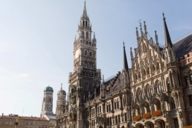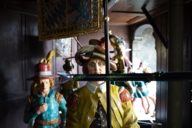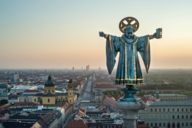
The New Town Hall is the home of politics in Munich and its balcony is also the place where FC Bayern greet their fans when they’ve won the championships.
- Glockenspiel
- Münchner Kindl
- Tickets and tours
- FAQ
With its ornate, Neo-Gothic facade, the Neues Rathaus (New Town Hall) at Marienplatz (square) looks slightly older than it actually is. As a matter of fact, initial construction took place between 1867 and 1905 after the neighbouring Altes Rathaus (Old Town Hall) became too small for Munich’s city council.
One of the most important attractions is the Glockenspiel in the hall's tower, whose daily performances at 11 am and 12 am (and 5 pm in the summer months) attract audiences from around the world.
The dancers' six waltzes to four different songs change on a monthly basis. Around 9 pm each evening, the Glockenspiel plays Richard Wagner's “Meistersinger von Nürnberg” and Johannes Brahms’ “Lullaby” to send the symbol of Munich, the Münchner Kindl, off to bed.
The Glockenspiel tells two stories from Munich's history:
The top layer demonstrates the marriage of Wilhelm V and Renate von Lothringen in 1568. To honour the bride and groom, a knights' tournament was held on Marienplatz.

The lower level shows the Schäfflertanz (the dance of the coopers). After a terrible epidemic of the plague, the barrel makers are said to have been the first people to risk stepping back out onto the streets, dancing for the amusement of the population gripped by fear of the disease.
A statue of the Münchner Kindl sits on top of the tower, watching over the city: the heraldic figure of the city, a monk, is often referred to as the Münchner Kindl (Munich child) – a title which is also available to anyone born in the city.
The Münchner Kindl (Munich child) is often a homorous childlike figure, which presents itself with a beer mug, radish and pretzel.
The first documented reference to Munich as “forum apud Munichen” (“near the monks”) dates from 1158. In the second half of the 19th century, a humorously cute figure emerged alongside the official “Münchner Kindl”, usually depicted holding a beer stein, radish or pretzel.
The advertising career of the defenceless Münchner Kindl really took off in later years: it posed to sell bicycle tyres, galoshes, wine, men's underwear, disinfectant, pasta, tropical fruits, cough sweets, fig coffee and innumerable other products. It even took up smoking (the extremely strong Zuban brand cigarettes) and also become a liqueur bottle (Riemerschmid).

The Münchner Kindl also appeared on wartime postcards and even on the election posters of political parties on all sides, though it must be said that people preferred to see it on posters for Fasching (Carnival) and, of course, Oktoberfest. Numerous three-dimensional versions have also been produced, generally as souvenirs in the form of dolls or key rings.
There is still a “real” Münchner Kindl that waves during the Wiesn-Einzug (the parade that marks the official opening of the Oktoberfest) and represents the city on other official occasions: since 1938, a young woman, usually from the family of an innkeeper, actor or brewer, has dressed up as the embodiment of this symbol of Munich each year.
However, the tower has a number of other impressive features: you can take the lift up to the viewing platform, where you can soak up a marvellous view over the old town. Tickets for the tower ascent can be booked online.
You will also get a glimpse of some exciting features during a 90-minute tour of the Neues Rathaus, which will take you through its grand rooms and to the building’s balcony, the backdrop for FC Bayern's championship celebrations.
During the tour, you will learn about the history of the building and the stories behind some of the city's historical figures who adorn the Neues Rathaus’ facade. Tickets are also available directly from the Tourist Information office in the Neues Rathaus.